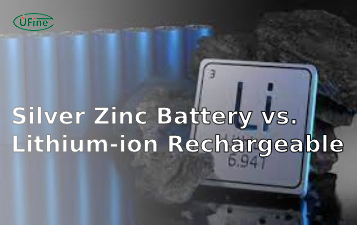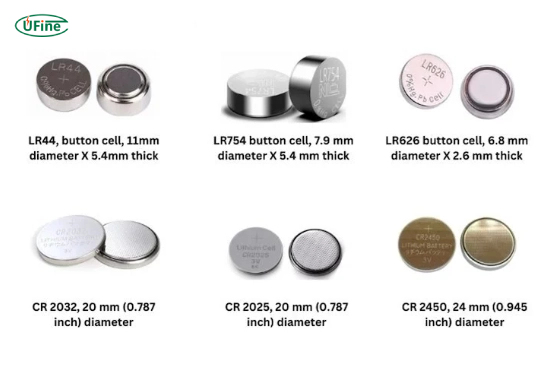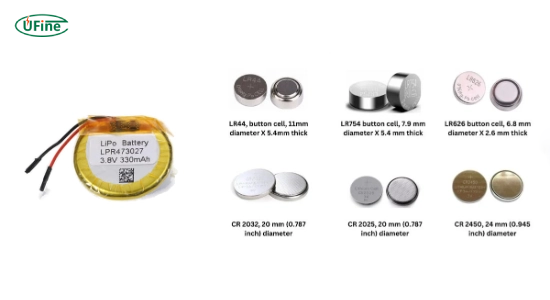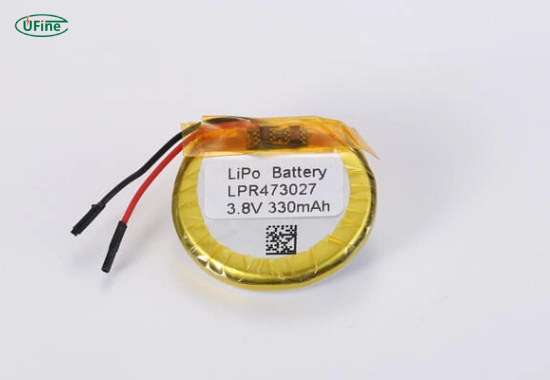
- Part 1. What are little round batteries?
- Part 2. How do little round batteries work?
- Part 3. What types of little round batteries exist?
- Part 4. What are miniature soft-pack lithium batteries?
- Part 5. How are little round batteries labeled?
- Part 6. What are the typical applications of little round batteries?
- Part 7. What is inside a little round battery?
- Part 8. How long do little round batteries last?
- Part 9. How are little round batteries manufactured?
- Part 10. Can little round batteries be recycled?
- Part 11. FAQs about little round batteries
Little round batteries are essential components in modern electronics, powering devices where space and reliability are critical. From wristwatches to hearing aids, and smart keys to medical tools, these compact energy sources are engineered to deliver consistent performance in miniature formats. But what exactly lies inside these tiny power cells? How do they function? And what advancements are being made in their design and chemistry? This guide explores the world of little round batteries, offering deep insight into their construction, types, chemistry, and applications, including the emerging role of miniature soft-pack lithium batteries.
Part 1. What are little round batteries?
Little round batteries, called button cells or coin batteries, are small, circular batteries used in compact electronic devices. They usually range in diameter from 5 mm to 25 mm and are designed to fit into devices that require a reliable power source but have limited internal space. These batteries are generally single-use, although some rechargeable versions exist.
While most people associate little round batteries with familiar coin-shaped cells like the CR2032, this category also includes ultra-thin soft-pack lithium batteries, which are increasingly used in wearables, medical patches, and smart cards. These newer formats are helping to redefine the performance standards of micro-scale power sources.
Part 2. How do little round batteries work?
The function of a little round battery is based on electrochemical reactions. Inside the battery, there are three primary components:
- Anode (negative electrode): Where oxidation occurs, releasing electrons
- Cathode (positive electrode): Where reduction happens, accepting electrons
- Electrolyte: The medium that allows ion flow between the anode and the cathode
When a battery is connected to a circuit, electrons flow from the anode to the cathode through the external circuit, powering the device. At the same time, ions move through the electrolyte inside the battery to maintain electrical neutrality.
The materials used for these components vary depending on the battery type, influencing the voltage, capacity, shelf life, and cost.
Part 3. What types of little round batteries exist?
There are several types of little round batteries, each designed for specific use cases. The most common types include:
Alkaline button cells- Typical voltage: 1.5V
- Common codes: LR44, LR626
- Chemistry: Zinc and manganese dioxide
- Applications: Toys, laser pointers, LED lights
- Pros: Inexpensive, widely available
- Cons: Shorter life and unstable voltage
- Typical voltage: 1.55V
- Common codes: SR44, SR626SW
- Chemistry: Silver oxide and zinc
- Applications: Watches, calculators, digital thermometers
- Pros: Stable voltage, long-lasting
- Cons: Slightly more expensive
- Typical voltage: 3V
- Common codes: CR2032, CR2025, CR2016
- Chemistry: Lithium and manganese dioxide
- Applications: Key fobs, remote controls, fitness trackers
- Pros: Long shelf life, high energy density
- Cons: Not rechargeable
- Typical voltage: 1.4V
- Common codes: PR44, ZA312
- Chemistry: Zinc and oxygen from air
- Applications: Hearing aids
- Pros: Lightweight, high energy capacity
- Cons: Short life after activation
- Typical voltage: 3.6V or 3.7V
- Common codes: LIR2032, ML2032
- Chemistry: Lithium-ion or lithium-manganese oxide
- Applications: Wearables, small electronics
- Pros: Rechargeable, long cycle life
- Cons: Requires a charging circuit
Part 4. What are miniature soft-pack lithium batteries?
A newer and highly specialized form of little round batteries is the miniature soft-pack lithium battery, often called ultra-thin lithium polymer cells. These batteries are flat, flexible, and extremely compact, making them ideal for integration into next-generation miniature devices.
Key characteristics:- Form factor: Flexible rectangular or rounded pouch
- Chemistry: Lithium-ion or lithium-polymer
- Voltage: Typically 3.7V
- Thickness: Can be as thin as 0.4 mm
- Applications: Smart cards, medical sensors, RFID tags, wearable electronics
Because of their flexible packaging materials, these batteries can be customized to meet advanced electronic designs’ unique shape and size requirements. They also offer higher energy density than traditional coin cells and support recharging, making them more sustainable.
Part 5. How are little round batteries labeled?
Battery manufacturers label button and coin batteries using a standardized code that helps users identify the battery’s chemistry, size, and voltage.
Decoding an example: CR2032- C: Indicates lithium chemistry
- R: Round shape
- 20: Diameter in millimeters (20 mm)
- 32: Thickness in tenths of millimeters (3.2 mm)
- LR: Alkaline
- SR: Silver oxide
- PR: Zinc-air
- LIR: Rechargeable lithium-ion
Properly decoding these labels ensures compatibility and prevents damage to devices.
Part 6. What are the typical applications of little round batteries?
Little round batteries are used in compact electronic devices due to their small size and dependable performance.
Common applications:
- Wristwatches
- Glucose monitors
- Fitness trackers
- Medical patches
- Digital thermometers
- Car remotes
- Laser pointers
- Smart rings
- Hearing aids
- Electronic toys
The growing trend of wearable technologies and Internet of Things (IoT) devices is increasing the demand for coin cells and soft-pack lithium batteries that can fit into thinner, more flexible formats.
Part 7. What is inside a little round battery?
The internal structure of a button or coin battery includes the following elements:
- Metal casing (usually stainless steel)
- Anode material (zinc or lithium)
- Cathode material (manganese dioxide, silver oxide, or air-based)
- Separator to prevent short circuits
- Electrolyte to carry ions
- Gasket or seal to prevent leakage
In soft-pack lithium cells, the metal casing is replaced with a foil pouch that is heat-sealed to contain the electrolyte. These batteries also use lithium cobalt oxide or lithium manganese oxide as the cathode and graphite as the anode.
Part 8. How long do little round batteries last?
The lifespan of a little round battery depends on several factors:
- Battery chemistry
- Device power consumption
- Frequency of use
- Temperature and storage conditions
- Alkaline: 6 to 12 months
- Silver oxide: 2 to 5 years
- Lithium coin cells: 3 to 10 years
- Zinc-air: 5 to 14 days after activation
- Soft-pack lithium: 300 to 800 charge cycles
Lithium batteries generally offer the best shelf life for devices in storage, while soft-pack versions provide longer operational life when used in wearable or rechargeable applications.
Part 9. How are little round batteries manufactured?
The manufacturing process of coin and soft-pack batteries involves strict precision and quality control.
Coin cell production:
- Stamping of metal casings
- Inserting electrodes and a separator
- Injecting electrolyte
- Sealing with a gasket
- Laser printing the label
Soft-pack lithium cell production:
- Coating electrodes with active materials
- Stacking or winding the cell
- Encasing in an aluminum foil pouch
- Vacuum sealing
- Formation cycling to activate the battery
Manufacturers often customize soft-pack lithium batteries for OEM clients to specific dimensions and capacities.
Part 10. Can little round batteries be recycled?
Yes, recycling is both possible and necessary. Most button cells contain materials like silver, lithium, zinc, or nickel, which are valuable and environmentally impactful if not properly handled.
Recycling tips:
- Store used batteries in a safe container
- Bring them to certified recycling centers
- Never incinerate or throw in household trash
Some soft-pack lithium batteries may be integrated into devices and require special disassembly before recycling.
Part 11. FAQs about little round batteries
Are little round batteries the same as soft lithium polymer cells?
They can be. While traditional coin cells are rigid and metallic, miniature soft-pack lithium batteries are newer in the same size range, offering flexibility and rechargeability.
Can I replace an LR44 with a CR2032?
No. These batteries differ in both size and voltage. LR44 is 1.5V and smaller in thickness, while CR2032 is 3V and larger in diameter.
Do all little round batteries contain lithium?
No. Only lithium coin cells (like CR2032) and soft-pack lithium batteries do. Others use alkaline, silver oxide, or zinc-air chemistries.
Are soft-pack lithium batteries safe?
Yes, when manufactured correctly. They include multiple safety layers, including overcharge protection, thermal shutdown, and short-circuit protection.
What should I do if a child swallows a button battery?
Seek immediate emergency medical help. Do not induce vomiting or give food or drink. The battery can cause severe internal damage very quickly.
Related Tags:
More Articles

What is the Difference Between Silver Zinc Battery vs. Lithium-ion Rechargeable?
Compare silver zinc and lithium-ion rechargeable batteries: energy density, cycle life, safety, cost, and uses in drones, medical devices, EVs, and electronics.
What are Watts and Watt Hours in Battery?
Understand watt vs watt-hour in batteries: key differences, how to calculate capacity, and why they matter. Includes free comparison table.
Best 10 Blood Pressure Monitor Battery Review: Finding the Most Reliable
Are you looking for a reliable Blood Pressure Monitor battery? Here is a complete guide with the top 10 best blood pressure monitor batteries.
Bluetooth Headphone Battery Guide: All You Need to Know
Maximize headphone battery life with expert tips! Learn how to charge, check, troubleshoot, and choose the best bluetooth headphone battery in 2025.
LiFePO4 Battery VS. Lithium-ion Polymer Battery: Which One Is Best?
Comprehensive comparison of LiFePO4 vs Lithium Ion Polymer batteries: energy density, safety, lifespan, cost. Find out which battery suits your needs in 2025.





